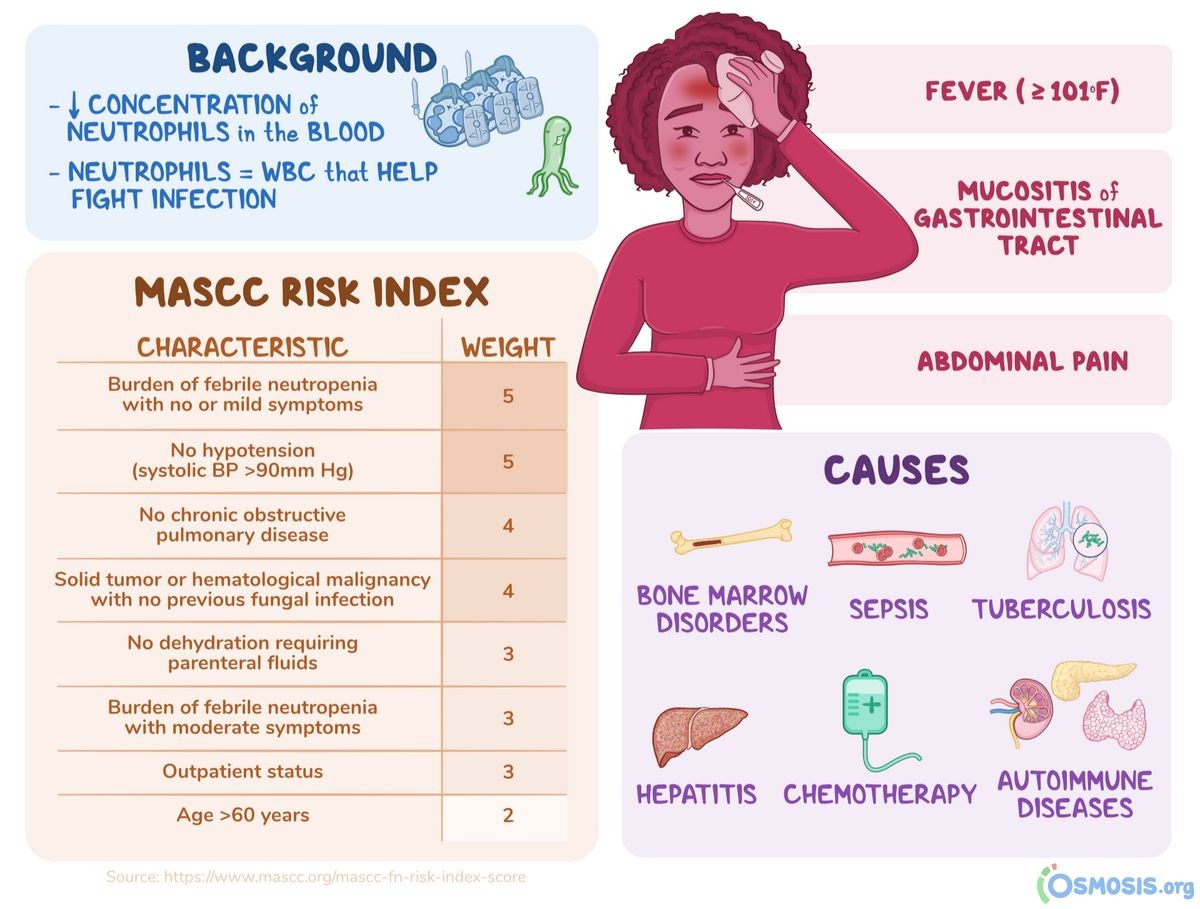
Contents
- 1 Neutropenia
- 1.0.1 What is neutropenia?
- 1.0.2 What are the signs and symptoms of neutropenia?
- 1.0.3 What causes neutropenia?
- 1.0.4 What are normal neutropenia levels and ranges?
- 1.0.5 Does neutropenia put a person at risk for bacterial infections?
- 1.0.6 How do doctors diagnose neutropenia?
- 1.0.7 What is the treatment for neutropenia?
Neutropenia
Symptoms and signs of neutropenia include fever, skin abscesses, mouth sores, swollen gum, and skin infections.
- Neutropenia is a condition in which the number of neutrophils in the bloodstream is decreased, affecting the body’s ability to fight off infections.
- Neutropenia is defined as an absolute neutrophil count (ANC) of less than 1500 per microliter (1500/microL); severe neutropenia is defined as an ANC of less than 500/microL.
- Neutropenia may be caused by or associated with numerous medical conditions including congenital disorders of the bone marrow, cancer chemotherapy, infections, certain medications (drug-induced neutropenia), and autoimmune disorders.
- Most infections that occur as complications of neutropenia are due to bacteria that are normally present on the skin or in the gastrointestinal or urinary tract.
- Treatment depends upon the cause and severity of the condition as well as the underlying disease state responsible for neutropenia.
What is neutropenia?
Neutropenia is a condition in which the number of neutrophils in the bloodstream is decreased. Neutrophils are a type of white blood cell also known as polymorphonuclear leukocytes or PMNs. Neutropenia reduces the body’s ability to fight off bacterial infections.
White blood cells are also known as leukocytes. There are five major types of circulating white blood cells:
- basophils,
- eosinophils,
- lymphocytes (T-cells and B-cells),
- monocytes, and
- neutrophils.
Some white blood cells, called granulocytes, are filled with microscopic granules that are little sacs containing enzymes. Neutrophils, eosinophils, and basophils are all granulocytes and are part of the innate immune system. They do not respond exclusively to specific antigens, as do the lymphocytes (B-cells and T-cells).
Neutrophils contain enzymes that help the cell kill and digest microorganisms it has engulfed by a process known as phagocytosis. The mature neutrophil has a segmented nucleus, while the immature neutrophil has a band-shaped nucleus. Neutrophils are made in the bone marrow and released into the bloodstream. The neutrophil has a life span of about 3 days.
What are the signs and symptoms of neutropenia?
Signs and symptoms suggestive of neutropenia include
- low-grade fever,
- skin abscesses,
- mouth sores,
- swollen gums, and
- symptoms suggestive of infections of the skin, perirectal area, mouth, or other areas of the body.
Pneumonia is an infection of the lungs that can occur in people with neutropenia.
What causes neutropenia?
Neutropenia can be present in normal healthy individuals, notably in some persons of African or Arabic descent and Yemenite Jews. Neutropenia may arise due to decreased production of neutrophils, destruction of neutrophils after they are produced, or pooling of neutrophils.
Neutropenia may arise due to numerous medical conditions:
- Infections (more commonly viral infections, but also bacterial or parasitic infections). Examples include: HIV, tuberculosis, malaria, Epstein-Barr virus (EBV);
- Medications that may damage the bone marrow or neutrophils, including cancer chemotherapy;
- Vitamin deficiencies (megaloblastic anemia due to vitamin B12 or folate deficiency);
- Diseases of the bone marrow such as leukemias, myelodysplastic syndrome, aplastic anemia, myelofibrosis;
- Radiation therapy;
- Congenital disorders of bone marrow function or of neutrophil production, for example, Kostmann syndrome;
- Autoimmune destruction of neutrophils or from drugs stimulating the immune system to attack the cells;
- Hypersplenism, which refers to the increased sequestration or destruction of blood cells by the spleen.
What are normal neutropenia levels and ranges?
The white blood cell count (WBC) is the number of white blood cells in a volume of blood. The normal range for the WBC varies slightly among laboratories but is generally between 4,300 and 10,800 cells per microliter or cubic millimeter (cmm). The WBC can also be referred to as the leukocyte count and can be expressed in international units as 4.3 x 10 9 to 10.8 x 10 9 cells per liter. The percentage of the different types of white blood cells in the WBC is called the WBC differential.
The absolute neutrophil count (ANC) is determined by the product of the white blood cell count (WBC) and the fraction of neutrophils among the white blood cells as determined by the WBC differential analysis. For example, if the WBC is 10,000 per microliter and 70% are neutrophils, the ANC would be 7,000 per microliter.
An ANC of less than 1500 per microliter (1500/microL) is the generally accepted definition of neutropenia. Neutropenia is sometimes further classified as:
- mild if the ANC ranges from 1000-1500/microL,
- moderate with an ANC of 500-1000/microL, and
- severe if the ANC is below 500/microL.
Some medical terms may be used synonymously with neutropenia, even though their precise definitions are different.
- Leukopenia refers to a reduced number of white blood cells in general, while granulocytopenia refers to a decreased number of all the granulocyte-type blood cells (neutrophils, eosinophils, and basophils).
- Since neutrophils normally far outnumber the other types of granulocytes, this term is sometimes used to refer to neutropenia.
- Finally, agranulocytosis literally refers to a complete absence of all granulocytes, but this term is sometimes used to refer to severe neutropenia.
Does neutropenia put a person at risk for bacterial infections?
Neutropenia results in an increased susceptibility to bacterial infections. The degree of risk depends upon the cause and severity of the neutropenia, the underlying medical condition of the patient, and the presence or absence of bone marrow reserves for the production of neutrophils.
The most common types of infection seen in neutropenic patients are caused by bacteria normally found on the skin or from the gastrointestinal and urinary tract. Fungal infections are also more frequent in patients with neutropenia. The infections may be limited to certain areas of the body or may spread via the bloodstream to the lungs and other organs in severe, prolonged neutropenia.
How do doctors diagnose neutropenia?
Neutropenia is diagnosed by a blood cell count performed on a sample of blood removed from a vein. To determine the specific cause of neutropenia in a given situation, other tests may be required. Sometimes a bone marrow biopsy may be required to diagnose the specific cause of neutropenia.
What is the treatment for neutropenia?
Treatment of neutropenia is based on the underlying cause, severity, and the presence of associated infections or symptoms as well as the overall health status of the patient. Obviously, treatment must also be directed toward any underlying disease process. Treatments that directly address neutropenia may include:
- antibiotic and/or antifungal medications to help fight infections;
- administration of white blood cells growth factors;
- granulocyte transfusions; and
- corticosteroid therapy or intravenous immune globulin for some cases of immune-mediated neutropenia.
Preventive measures may also be implemented in neutropenic patients to limit the risk of infections. These measures might include strict attention to hand washing, the use of private rooms, or in some cases, the use of gloves, gowns, and/or face masks by caregivers.


